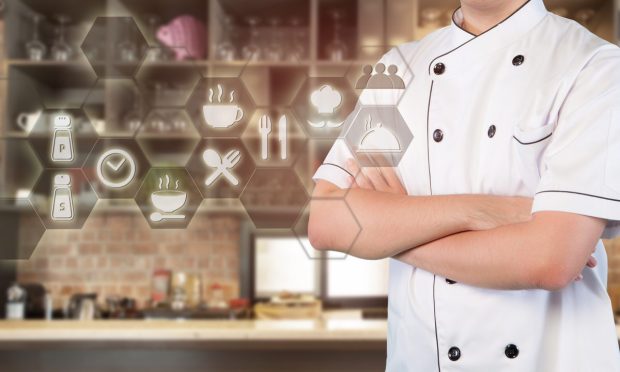Hyphen’s Restaurant Robotics Fend Off Delivery Giants

We may not have Jetsons-style food machines or Wallace & Gromit autochefs in our kitchens just yet, but food production automation is accelerating. From salad-making robots to pizza creation automation systems to robot baristas, innovations are coming to the fore each month.
Related news: Could DoorDash’s Latest Acquisition Herald The Automated Future Of Food Prep?
Automation In Foodservice And Prep Eases Restaurant Labor Shortage Challenges
While the space has been growing for years, the digital ordering boom of the past year and a half is speeding up the process. In June, Clayton Wood, chief executive officer at robot-as-a-service (RaaS) company Picnic, spoke with PYMNTS about how digital ordering has created more of a demand for automated solutions. Now, Stephen Klein, co-founder and CEO of Hyphen, a tech company that just launched the first robotic makeline, shares with PYMNTS how the channel has also changed what consumers look for from their food order, making them more receptive to automation.
Read more: Kitchen Automation Turns Digital Order Volume From Challenge To Opportunity
“I’d say partially automated or semi-automated food production — that’s going to be the norm within five to 10 years, no doubt,” Klein said. “If you’re ordering from your phone, and the only interaction you’re having with the restaurant is through that digital device, it really doesn’t matter who’s making your food, as long as it’s fresh, fast and consistent.”
In fact, PYMNTS’ study, The Bring-It-To-Me Economy: How Online Marketplaces And Aggregators Drive Omnichannel Commerce, created in collaboration with Carat by Fiserv, finds that 6 in 10 U.S. consumers are ordering restaurant meals online more now than they were before the pandemic, and almost half are ordering food online to be delivered more often than before March 2020.
See also: New Study: Bring-It-To-Me Economy Ascends As Consumers Embrace Home-Centric Lifestyles
For its part, Hyphen now has signed deals to deploy its Automated Makeline, which can create produce 350 meals in one hour with the help of a single worker, in 300 locations, predominantly restaurants.
‘The Perfect Storm’
Of course, the rise in digital ordering was not the only pandemic-related factor that led to growth in the food kitchen space.
“We got a lot of tailwinds because of the pandemic,” Klein said, adding that the outbreak was “kind of a system shock.”
He highlighted two factors in addition to the rise in off-premise ordering: the labor shortage, which he attributes to the lack of increase in minimum wage, and the “huge uptick in order defects” that came with the surge in delivery orders. He reflected, “It kind of created the perfect storm.”
The food space is also growing more fragmented now than it was in 2019, with micro-celebrities emerging in food through social media platforms such as Instagram and TikTok, presenting an opportunity to leverage their existing, loyal audience to drive sales, especially if they can take advantage of technologies that lower the barrier of entry for developing a new brand.
“There’s this long tail of hyper-niche brands that cater to a specific cuisine or celebrity or person, and I think our system works really well for that,” he said, hinting at an upcoming partnership with a celebrity with a broad audience and adding that, by offering the ability to produce more orders in less time, automation offers the ability to meet this elevated demanded.
Ghost Kitchen Busters
Most of the business owners and executives benefitting from the rise in ghost kitchens view the delivery-only model as a huge plus for their bottom line, with many also framing it as a boon for the industry on the whole.
Klein, however, sees Hyphen’s Makeline as an alternative to the model. He argues that it presents the opportunity for restaurants to similarly optimize their order production capabilities from their own kitchens, instead of having to outsource to remote locations.
He cited CloudKitchens as an example, noting that their Los Angeles location in Pico-Union is far from the customers, and that its far-off location makes it harder to keep in touch with the team and to protect proprietary information.
“You add to that the chaotic experience of multiple brands coming in out of these kitchens with very little oversight, you start to worry about trade secrets and stuff,” he said, adding that there are data concerns in partnering with many of the major ghost kitchen companies, depending on the terms of the agreement.
Arming David Against Goliath
“It’s my view that every meal that’s delivered to a door will effectively be automated by some form of food production,” Klein predicted. “I think that future is quite certain.”
His ideal future for the restaurant industry would be one in which anyone with a clear culinary vision had the capacity to bring their foods to a wider audience, adding that Hyphen aims to reduce the cost of running a restaurant enough to make that possible.
However, he believes that the major delivery services pose a threat to this future, risking running restaurants on their platform out of business. He cited the example of Amazon, which began pricing out against vendors on their own marketplace with more affordable Amazon Basics versions of their products, while Shopify gave brands the tools they needed to hold their own. Now, restaurant aggregators are launching restaurant brands, creating a similar dynamic.
See also: DoorDash Opens Second Virtual Kitchen
“I see us as arming the rebels to compete with DoorDash,” Klein said. “DoorDash is now doing their own food brands, and we want to arm David to compete against Goliath.”
